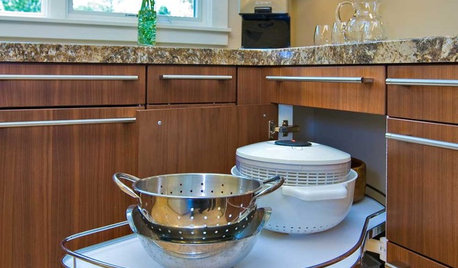I almost titled this posting:
GEEKY WORM FANATIC: WHY DO I ALWAYS MAKE THINGS SO COMPLICATED?!
I started with a five-tray VermiHut system and two pounds of Eisenia foetida several months ago. My household of four produces about one to two pounds of fruit and veggie scraps per day. My goal was to be able to vermicompost all of our fruit and veggie scraps. My basic understanding was that these worms can eat half their body weight per day. So my reasoning was that if I could feed a pound of scraps a day into the composter, the two pounds of worms should be able to handle it. Of course I realize I can't come out of the gate like that - I took a month or so of feeding them much less and letting all the micro-eco-system get going before I got up to the full amount, and it worked pretty much awesomely.
There are two basic problems I have encountered.
PROBLEM 1: The first is that the worms don't eat fresh food down by the next day - not really a problem, except that a single tray can't accommodate an addition of one full pound of food per day without beginning to mold and turn into a cesspool. As I'm sure all of you know, once the food to bedding ratio becomes too high, you have a mess.
SOLUTION 1: What I did was to get four trays going in pretty short order. The fifth tray I simply filled with fresh bedding and left it at the bottom to serve as a barrier to prevent worms from falling into the leachate collection (they had been doing so from day one) - I didn't add food to it. The other four trays I put onto a rotation system. Each day, I'd put our kitchen scraps into the top tray and then put it on the bottom. If the trays were numbered 1 through 5 (One at the bottom), then each day I'd take number 5, put food in it, and then move it to the number two position. The numbers 2 through 4 then all move up one level. By the time the original number five moved back up to the number five position four days later, the food would be mostly gone and I could add more food. No worms fell in the leachate, the composter never began to smell, and all of our kitchen scraps were being processed.
PROBLEM 2: The trays became too heavy, and I was afraid of squishing worms. One tray isn't so bad. But in order to put number 5 on the bottom, I had to put it on the ground, then lift numbers two through four (all at once) onto it, and then lift all four back into the VermiHut. Because there were always lots of worms hanging from the bottom of number five, I was afraid I would squish them if I put the tray onto a flat surface. Also, my arms were getting really tired lifting three and four full trays at a time. Now our worm population is exploding (good, because so is our food scrap production). So the trays will get heavier, and I think I may need more trays.
SOLUTION ??? My concern with getting more trays is that they will get too heavy for me to lift and that too tall of a stack will squish the worms. So I thought about it and considered getting another identical VermiHut tray system, and use six to eight trays between it. Each day I could put the scraps in the top tray of composter A, and then transfer it to composter B. When I've used the last tray from composter A, then I reverse the process. No worm squishage on flat surfaces, no lifting more than one tray at a time. Maybe some of the trays get a double-dose of food close together, but it will be double the time before I add food to it again, so it should all work out.
Also, separating out the cocoons to let them hatch before harvesting the compost was tedious, so I took the suggestion from one of the posts in this forum. I took all the worms out of the compost and then set the cocoon-laden compost aside in a separate bin until they hatch. With a third VermiHut system, I could just designate it "the nursery" and segregate out a worm-free but cocoon-laden tray until they all hatch without disturbing them.
So I was all ready to go spend seventy bucks and buy another system and get the composter A and composter B and the nursery composter all ready and it suddenly hit me that this seems a little complicated and convoluted. I thought, AM I OVERTHINKING THIS? Is my geeky brain making this more complicated than it needs to be? (I won't say it hasn't happened before). Maybe there is a better way. Maybe I'm so caught up in the details that I'm missing a bigger, simpler, easier solution and system.
So I turn it over to you and ask for your thoughts. How can I add more than a pound of food per day to a vermicomposting system without creating a cesspool or breaking my back with the lifting?
















lubowsky
Worms4TracyOriginal Author
Related Professionals
Saint Louis Park Landscape Architects & Landscape Designers · Chelmsford Landscape Contractors · Mastic Beach Landscape Contractors · New Braunfels Landscape Contractors · Waldorf Landscape Contractors · West Orange Landscape Contractors · Whittier Landscape Contractors · Shenandoah Landscape Contractors · Jericho Stone, Pavers & Concrete · Dover General Contractors · Evans General Contractors · Hampton General Contractors · North Tustin General Contractors · Selma General Contractors · Waipahu General Contractors